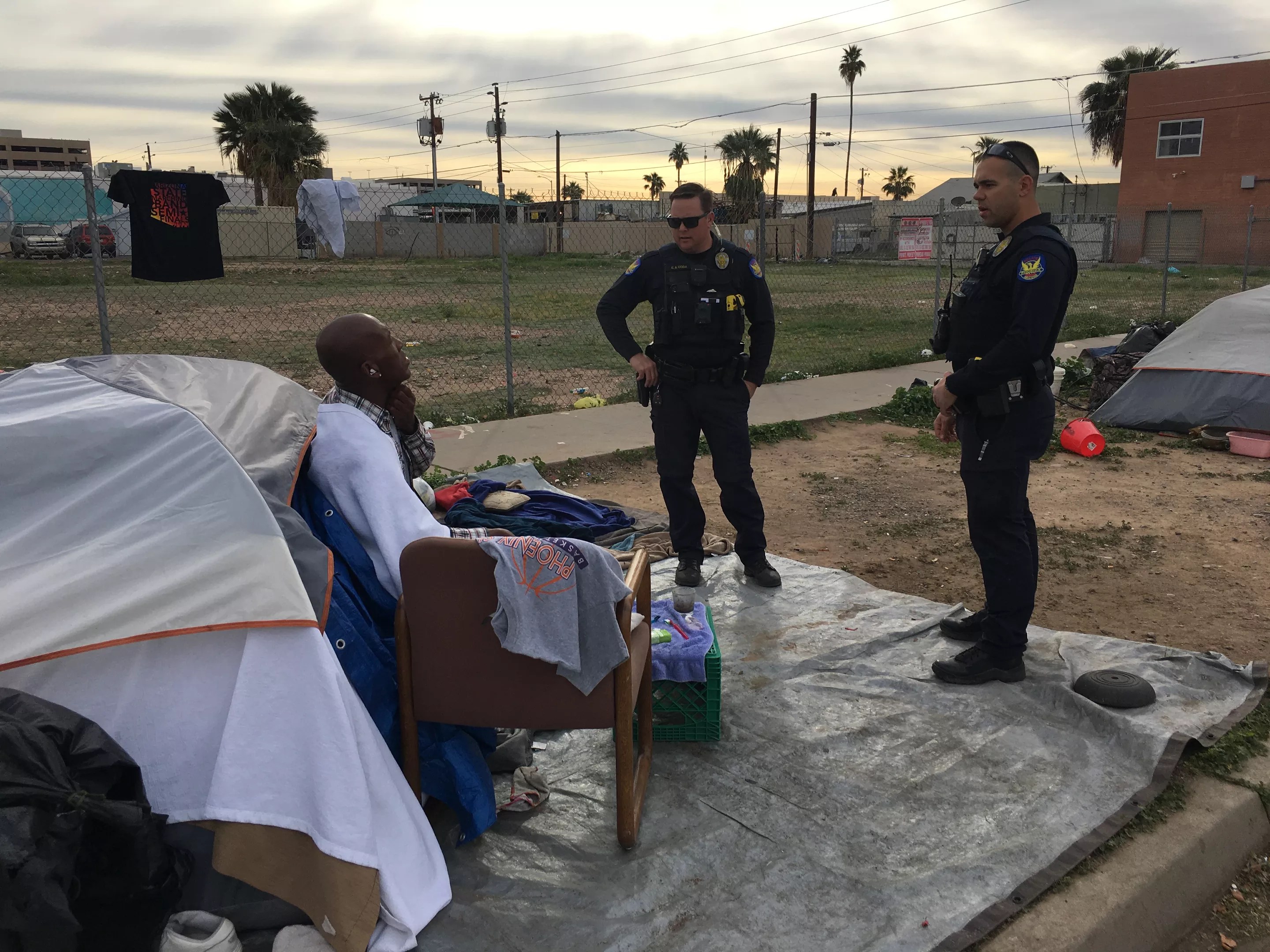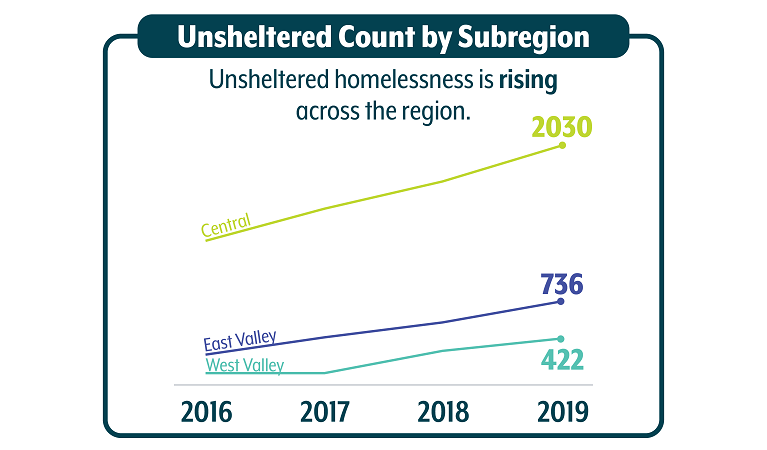
Elizabeth Whitman

Audio By Carbonatix
Facing growing pressure to address Phoenix’s homeless crisis, Mayor Kate Gallego said Tuesday that she would support a bid from the Human Services Campus in downtown Phoenix to double the number of shelter beds there.
The move represents a reversal for Gallego, who previously opposed the increase in beds in downtown Phoenix.
In a press conference Tuesday laying out the broad contours of a new plan to address homelessness in Phoenix, Gallego maintained that in the long run, she believed shelter beds should be dispersed in cities across the Valley, not concentrated in downtown Phoenix.
She also argued that other cities, Maricopa County, and the state of Arizona all need to do more to help address the rising number of homeless people in America’s fifth-largest city.
The press conference became briefly dramatic thanks to an unexpected visit by Council Member Michael Nowakowski, who shoved his way into the conference, despite an aide pushing him back, to protest her decision.
Gallego said she would “tentatively support” the special zoning request from the Human Services Campus to add 500 beds to the 470 beds the Central Arizona Shelter Services, which is located on the campus, has now.
That support now comes with strict parameters, Gallego said, including close collaboration with downtown community members, who have been vocal about problems they’ve witnessed or experienced stemming from homelessness in their neighborhood.
She is also asking for an annual review of the zoning for the first five years – an atypical requirement – and quarterly meetings with the community for the first three years.
If those requirements are not met, she would not support the special zoning request, Gallego warned.
In the long run, she said, she believed that shelter beds should be spread out across the county “in a smaller regional model.” Ideally, those shelters would have 100 to 200 beds and be embedded in the community.
But, she added, “I also realize that on the path to change there must be compromise.”

A person sleeps outside Phoenix’s City Hall on March 3, 2020.
Elizabeth Whitman
On top of the fact that more than 2,000 people in Maricopa County have no permanent home, the city is facing fierce outcry from residents who are directly affected by people living on the sidewalks next to their homes.
In a mass email to Gallego, Council members, the city manager, and several media outlets on Monday night, the Madison Pioneers Coalition voiced fear and fury stemming from the crisis of homelessness at their doorsteps.
They sent several photos, one showing a man who appeared to be shooting up, “taken from the bedroom window of one of our members on 11th Ave.” Two other photos showed trash fires and a “deranged girl,” who was nude.
The group represents Phoenix residents living in the vicinity of the shelter and the massive nearby encampment of people the shelter cannot accommodate, and it has asked the city to provide an emergency temporary shelter shelter.
“Then the City can take all of time they want to come up with a more permanent solution,” the group wrote.
The email continued, “Many families have children in school around here … This neighborhood has become the dumping ground for homeless, vagrant, mentally disabled, and ex felons for all the surrounding cities.”
Ultimately, the group concluded, “We believe it is negligent of the City to allow this.”
Another part of the city’s broader plan to address homelessness is by increasing a variety of resources for people who are homeless or at risk of losing their housing.
Gallego said she has asked for 100 housing vouchers to be set aside specifically for seniors, who are often on fixed incomes that put them at unique risk of losing housing. The city has 455 units of affordable housing under construction this year, which she said represented a 250 percent increase over any year in the last decade.
She also called for more longer-term resources from the county and state to help with mental health services, public health, and affordable housing.
The City Council is scheduled to vote on Wednesday to proceed with formulating the plan. Provided it allows the plan to move forward, the city manager has until June 1 to deliver it.
Hamstrung
In her prepared remarks and in answering questions, Gallego repeatedly said that Phoenix is bearing the burden of Maricopa County’s homelessness crisis.
“I hope that if the city steps up, it will inspire others,” she said.
Gallego also offered implicit criticisms of the way the state in particular has undercut cities’ abilities to address issues of homelessness and affordable housing in the long run.
As Gallego noted, in 2007, Arizona’s State Housing Trust Fund, which is supposed to help low-income families with housing, had $40 million. In 2010, it was slapped with a cap of $2.5 million; last year, it got $15 million.

She also pointed directly to a state preemption law signed in 2015 that bars cities and counties in Arizona from requiring developers to build affordable units or homes. Under that law, it is illegal to require that housing “be designed for sale or lease to any particular class or group of residents.”
“The state has barred cities from asking developers to create a certain number of affordable units in new developments,” Gallego said. “Cities should be given more tools to develop affordable units, not fewer.”
Although 40 percent of Maricopa County’s population lives in Phoenix, the city has 83 percent of all emergency shelter beds in the county, she said twice during the press conference.
“The way to fix homeless is not congregating individuals from across a region into one neighborhood,” she said.
In recent years, Phoenix has grappled with rising numbers of people who are homeless and a dearth of shelter beds and affordable housing.

The point-in-time count show the number of sheltered and unsheltered homeless people in Maricopa County on a single night each year.
Over the last six years, annual point-in-time counts, which are an attempt to tally and survey all people who are homeless on a single night in January, show a growing number of people struggling with homelessness and, in particular, with finding shelter.
On the night of January 21, 2019, 6,614 people in Maricopa County were found to be homeless. In 2018, it was 6,298; in 2017, 5,602 people. Those numbers include people with shelter (a bed somewhere, maybe in a homeless shelter or in transitional housing) and without (on the streets, or in a tent).
Although the total number of people who are homeless has fluctuated slightly since 2014, it has risen overall, while the number of unsheltered people has grown every year, numbers published by the Maricopa Association of Governments show.
Over the same time period, the number of people who are chronically homeless has risen by 139 percent. Chronic homelessness is defined as being homeless for at least a year straight, or four or more times in the last three years.
In the short term, before the city can begin to put its new plan into action, Phoenix is working on providing more bathrooms for people camped out near the Human Services Campus, including possibly opening the bathrooms at the shelter itself, which is typically closed during the day.
It has added two dumpsters, and the city comes through five times a week to empty them. Cleanups currently happen once per week, and according to Tamyra Spendley, the deputy director of human services for Phoenix, officials are considering doing more intensive cleanings.
Nowakowski Interrupts

Phoenix Mayor Kate Gallego, flanked by Council Member Debra Stark, looks at Council Member MIchael Nowakowski as he interrupts a press conference on March 3, 2020.
Elizabeth Whitman
Shortly after Gallego began her press conference on Tuesday morning, District 7 Council Member Michael Nowakowski angrily crashed it, despite one aide physically pushing him back.
“I’m allowed to come in here,” he said as he pushed his way into the room.
Gallego kept speaking, about how elected officials needed to come together across boundaries.
As she wrapped up her prepared remarks and offered to take questions from the media, Nowakowski interrupted.
“I have a question. Can I set up a meeting with you to talk about CASS, that’s in my district?” he said. “I asked for a meeting, and you’re having press conferences talking about what’s going to be affecting my community!”

Phoenix Council Member Michael Nowakowski interrupts Gallego
Elizabeth Whitman
“You went out there saying that you were against this project; now, you’re switching your tune,” he said accusingly. “I need to understand why and not get this information in front of the media.”
“I believe we are in a crisis situation and we need to step up,” Gallego replied, nonplussed. “I appreciated your request for a meeting that you delivered this morning, in the elevator, an hour ago.”